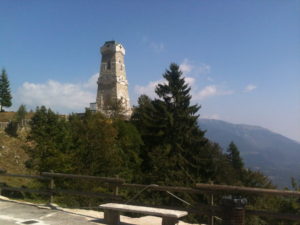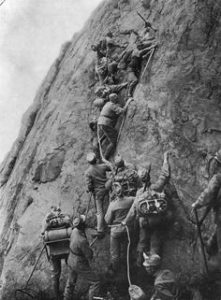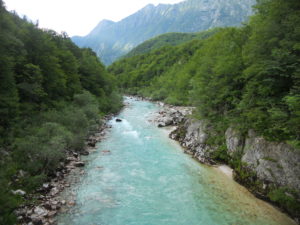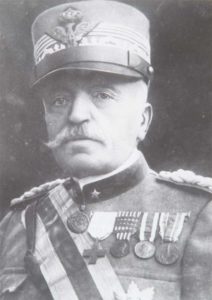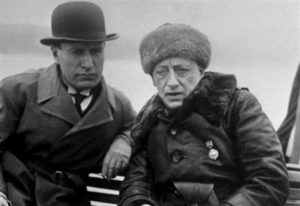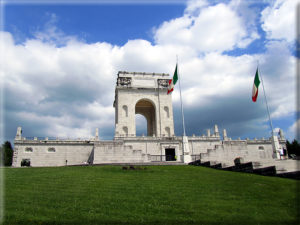Great WWI-era Austrian Writers: Musil, Zweig, Roth
During this ongoing centenary of the First World War, I became more interested in the details of the Italian front in that war, a campaign not generally well-known to Anglophones like me. It did not take me long to realize that I was also quite ignorant, historically speaking, of their opponent—the Austrian-Hungarian empire. A friend recommended Robert Musil’s The Man Without Qualities as a very philosophical novel that I would appreciate. From there I discovered Joseph Roth’s Radetzky March and other novels, and Stefan Zweig’s varied fiction and his memoir, The World of Yesterday.
All three writers, Musil (1880-1942), Zweig (1881-1942), and Roth (1894-1939), share many similarities. The first thing is that they were all exact contemporaries. They were all born and came of age at the height of fin de siècle Viennese culture. They were all outsiders in that society to some extent. Zweig and Roth were both secular Jews, and Musil’s wife was Jewish. All three had books burned, and were ultimately destroyed themselves by the Nazis. Like almost everyone, they were affected by the First World War, and dedicated most of their authorial attention to describing Austrian society before and after the war. All three were preoccupied by suicide, a prevelant theme in Viennese culture then. They were dedicated to literature and the arts, and despite different styles, I believe them to be among the greatest writers of the first half of the century in any language.
When I realized that Musil’s magnum opus The Man Without Qualities was over 1000 pages, I decided to approach him via a more accessible route. His early novel The Confusions of Young Törless is also critically acclaimed, and I immediately understood why. Published in 1906, Törless is a Bildungsroman about young boys in an all-male military boarding school, mirroring Musil’s own early experience. It is both disturbing and fascinating how Musil probes the psychology and motivations of the three main characters in forming a sort of triumvirate of power over the other boys in the class. This early novel also vaguely foreshadows the latent cruelty and bigotry combined with Germanic militarism that would devolve into the future Nazi state.
The Man Without Qualities (Der Mann ohne Eigenschaften) was Musil’s ongoing project from the early 1920s until his death in 1942. It is very openly a “novel of ideas,” somewhere between The Brothers Karamozov and The Magic Mountain. It is easily one of the greatest works of high Modernist fiction, somewhere between Ulysses and In Search of Lost Time. Though unfinished, its three volumes run to over 1700 pages in some editions, and around 1100 for the English translation. The unusual title refers to the protagonist Ulrich, a young mathematician who is searching for something like a meaning and morality to combat his seeming indifference to life and his place in bourgeois society. There are several other unforgettable main characters: especially Diotima, a cultural muse for Viennese society who held philosophical salons, and her would-be lover Arnheim, a wealthy Prussian businessman who also writes popular books of essays and rivals Ulrich’s intelligence. A character named Moosbrugger, a hulking laborer who murders a prostitute, provides an ongoing digression and topic of moral and legal interest for Ulrich.
As Musil had already demonstrated in an earlier volume of tales called Five Women, he had a particular talent for creating rich and interesting female characters, especially compared to other male writers from his time. In addition to Diotima, there is Clarisse, a more intellectual Holly Golightly-type, Bonadea, Ulrich’s bored housewife lover, and Agathe, his mysterious sister that appears only in the last part of the novel.
It seems like Musil’s ambition and his intellect were almost too much to be contained in this single sweeping novel. As a novelist, he seems too big for his time. The Man Without Qualities, written in the 1930s during the slow buildup to a bigger war, is set in the period just before the First World War. The main plot deals with the so-called Parallel Campaign, a military-like campaign to plan and execute a national celebration for the 70th year (!) of Emperor Franz Joseph’s reign which would occur in 1918 (the reader knows this never occurred, as he died in the middle of the war). There were never any specific proposals drawn up, but it was to be a earth-shaking event of cultural and political importance that would remind the world of the centrality of the Austrian nation. It would also, by definition, compete against and surpass the simultaneous Prussian celebration of Kaiser Wilhelm’s 30th year of rule. Ulrich was named as the secretary to the Parallel Campaign’s director, and all the meetings were held in Diotima’s salon. The fact that this event was founded in such a cultural and philosophical milieu is at odds with the real history of the upcoming war that Musil, and the reader, are all too aware of. The best way to describe The Man Without Qualities would be combining a satire of Austrian pre-war society with lyrical philosophical musings.
The novel itself is modernist in the sense that it is ironically self-aware and metafictional. It has chapter titles like Chapter One: “From which, remarkably enough, nothing develops.” While the strength of the characters and the ideas are enough to propel the narrative for quite a while, it is true that the main plot increasingly feels bogged down by inertia as the pages multiply. At the same time, this fact itself, even considering that the book remained unfinished at Musil’s death, feels almost intended. One gets the sense that this novel contains Musil’s expression of despair over the First World War and all that was lost as well as a sense of the coming disaster of the next war. It feels as if this novel is Musil’s alternate reality for an Austria and Europe that never fell into destructive war, while also satirizing the petty faults of the society that vanished in that war to be replaced by greater crimes and less humanity.
The last part of the novel is also the most inchoate and dreamlike, wherein Ulrich rediscovers his alienated younger sister in their family house away from Vienna. The pair regress into some sort of fantasy world while most of the plot and the world around them seems to gradually disappear. Even with its faults and difficulties, The Man Without Qualities is and will remain a book for serious readers and thinkers for all time.
Joseph Roth’s masterpiece is the 1932 novel Radetsky March, which follows the gradual decline of the Austrian Empire from 1859 until World War One. If Musil’s work is comparable to modernist writers like Proust, Roth’s novel is nothing less than a shorter and more ironic version of War and Peace. It follows three generations of the von Trotta family from the disastrous Battle of Solferino, which forced Austria to give up much of its Italian territory, to the middle of the Great War. It follows various characters, from servants to the Emperor himself, who is depicted with an empty brain and a constantly dripping nose. At the aforementioned battle, the founder of the von Trotta “dynasty” was a Slovenian lieutenant who stepped in front of an Italian bullet destined to kill the the young Franz Joseph. He survived and was ennobled by the grateful emperor, who thereafter followed his savior’s career closely. The event became enshrined in legend and magnified in children’s schoolbooks, so that the elder von Trotta became the famous “Hero of Solferino.” This hero was so uncomfortable that he prohibited his own son from entering the military, and eventually called upon the Emperor himself to denounce the embellished version of the event.
The Battle of Solferino, though little known today, was one of the biggest and most important battles in Europe in the century between Napoleon and WWI. It was the last battle in history where the armies were all under the command of their respective monarchs (Napoleon III, Vittorio Emmanuele II, and Franz Joseph). It was so bloody that it led directly to the founding of the Red Cross and the establishment of the Geneva Conventions for armed conflicts. It was a disaster for Austria, which was forced to give up its richest Italian province, Lombardy. It was the first big loss for Austria in a series of setbacks that continued unabated until the Empire was disbanded following WWI, just after the end of Franz Joseph’s 66-year reign. The symbolism of starting the novel with the Battle of Solferino is thus appropriate foreshadowing of the bigger tragedies to come, written as it was a over a decade after WWI of hardship and poverty for the new rump state of Austria.
The opening lines of the novel set a powerful and elegiac tone for the lost past and lost future of Austria and Europe, as seen from the early thirties:
“BACK THEN, BEFORE the Great War, when the incidents reported on these pages took place, it was not yet a matter of indifference whether a person lived or died. If a life was snuffed out from the host of the living, another life did not instantly replace it and make people forget the deceased. Instead, a gap remained where he had been, and both the near and distant witnesses of his demise fell silent whenever they saw this gap. If a fire devoured a house in a row of houses in a street, the charred site remained empty for a long time. For the bricklayers worked slowly and leisurely, and when the closest neighbors as well as casual passersby looked at the empty lot, they remembered the shape and the walls of the vanished house. That was how things were back then. Anything that grew took its time growing, and anything that perished took a long time to be forgotten. But everything that had once existed left its traces, and people lived on memories just as they now live on the ability to forget quickly and emphatically.”
Roth wrote a sequel to Radetsky March called The Emperor’s Tomb in 1938, the year before his death. It is curiously different in tone and style from the earlier novel; the high realism and irony is replaced with a more comical cynicism and looser narrative structure. It follows a character from another branch of the von Trotta family, and a Polish character related to a wealthy count in the earlier novel; otherwise there is no internal reference or connection between the two novels. The Emperor’s Tomb is set in Vienna after the end of the war, where inflation, depression, and growing extremism now reign in place of the defunct emperor.
Roth’s first novel was 1924’s Hotel Savoy, set in the real and still existing namesake hotel in Łódź, Poland. The hotel serves as a way point and meeting place for soldiers making their way home from the eastern front after the war, along with a variety of other richly drawn character types. It is an almost journalistic account of the broken dreams but still abundant hope people had after the recent war. Here is a taste of the type of muscular melancholic prose Roth employs in this early novel:
“Things were going badly with these people. They prepared their own destiny and yet believed that it came from God. They were prisoners of tradition, their hearts hung by a thousand threads and the threads were spun by their own hands. Along all the ways of their lives stood the thou shalt not of their god, their police, their kings, their position. In this direction they could go no further, and in that place they could stay no longer. And so, after a couple of decades during which they had struggled, made mistakes and not known which way to turn, they died in their beds and bequeathed their wretchedness to their descendants.”
Roth cranked out many short novels very quickly in order to make a living during his unhappy years of exile and alcoholism. None of these reach the greatness of Radetsky March, but the best of them is, I think, Job. It is a sort of morality tale of the Galician Shtetl Jewish community that Roth grew up, in which a desperately poor family reclaims a lost son in America. He deals with his Jewish roots in other books such as Leviathan, The Silent Prophet, and The Wandering Jews. The Antichrist is a sort of novelistic cri de coeur against the wave of violence and anti-Semitism in his native land, where his books went up in flames. He drank himself to death in Paris the year after the Anschluss, and a few months before the beginning of the new war he had long seen coming.
Stefan Zweig was a prolific writer and cultural figure in the three decades leading up to his death in 1942. His books were popular and best-selling throughout the 1920s and early 30s not only in the German world, but in Europe and the Americas. He grew up in a wealthy, non-religious Jewish family in Vienna. He wanted to be a writer since childhood, and published continuously in a variety of genres from age 19 to his death at 60. His fiction mostly consists of short stories and novellas, and only two full-length novels (one of which, The Post-Office Girl, was unfinished and published posthumously). He also wrote popular biographical and historical works, many of which celebrate his literary idols and influences, such as Balzac, Dickens, Dostoevsky, Rolland, Verlaine, and Nietzsche. Others include figures such as Marie Antoinette, Mary Stuart, Erasmus, and Magellan. He also wrote a few plays, plenty of journalistic articles, and a well-known autobiography, The World of Yesterday.
Zweig was a good friend and admirer of Freud, and that influence shows up constantly in his work. His fiction, but also his biography, is very focused on the psychological motivations of the characters. In a great number of his stories and novellas, the main events turn upon the obsessive and sometimes destructive personal and sexual relationships between characters. This was something not commonly found in literature of the time; Zweig, like Musil, was thus on the cutting edge of psychological writing of the 20th century. His works are the most accessible and entertaining of the three writers I have discussed. His style was fast-paced and full of surprise developments. His novel Beward of Pity, for example, is a real page-turner. Most of Zweig’s work is so short because his editing style was to cut as much as possible until only what he considered essential to moving the story forward remained (something that could have served Musil well). In addition, his stories are particularly rich in complicated frame narratives in the form of second-hand narrators, discovered letters, etc., which is an old literary technique that is difficult to pull off convincingly and often outgrows its welcome; nevertheless, Zweig somehow seems to enrich his fiction each time he uses this technique.
One of Zweig’s best stories, in my opinion, is “Mendel the Bibliophile”. It tells of an old Jewish book merchant who sits in the same cafe all day everyday and has a flawless encyclopedic memory of every page of every edition of every book, or at least every book that has moved through Vienna or Central Europe. He is taken away to a concentration camp when WWI starts, and when he returns years later, everything is changed and hostile. It is a rich and sad tale that, like much of Zweig’s work, is evocative of the rich cultural and intellectual life of pre-war Vienna, and laments the destruction of that world by the war. The title and theme of the book also prefigure later stories by Jorge Luis Borges, who had no doubt read Zweig (who was one of the main delegates at the 1936 PEN conference in Borges’ home of Buenos Aires).
Another of my favorites is the 1941 novella Chess Story, the last fictional work Zweig finished and published before his death. It tells of two incredible and highly unconventional chess masters who meet on a transatlantic ocean liner en route to South America. It is revealed that one of the men was imprisoned and psychologically tortured by the Nazi regime, but was eventually able to steal a small book from a guard’s coat that turned out to be a chess manual. Like most of Zweig’s work, it is insightful and sensitive to the vicissitudes of human suffering and success. In his novel Beware of Pity, the narrator says something which I think applies to the author himself: “Once you have gained some understanding of human nature, further understanding of it seems to grow mysteriously, and when you are able to feel genuine sympathy for a single form of earthly suffering, the magic of that lesson enables you to understand all others, however strange and apparently absurd they may be.”
Zweig is well-known also for his memoirs The World of Yesterday. The writer, typically focused on minor transformative episodes in his character’s lives rather than big political issues, revealed the depth of pain he felt by the senseless violence of the First World War which shattered the Viennese culture he knew and loved as well as his vision of a unified, cosmopolitan, peaceful pan-European culture. This book is a must-read for anyone interested in learning more about pre- and post-war Austrian society, but it is also one of the most distinctive memoirs I have read in general. After he sent it to his publisher, Stefan Zweig and his wife killed themselves in their new home in Brazil, in despair of the seemingly unstoppable Nazi advance and what it would bring.
All three of these writers were, as I have said, hugely important writers in Austrian culture, but were also enemies of the culture and society that developed between the two wars. In addition to the millions slaughtered in vain in that infinite human folly known as World War One, these three writers were among the tens of millions who were gradually broken by the suffering brought about due to the first war and leading up to the next war. Although Austrians, and, from the Allied perspective, on the “enemy” side, these three writers, like all artists, transcended their national birthright by means of the universal and timeless art they produced. I have profited and enjoying reading all of them much more than any mere history of the wars they abhorred.
Extra author postscript: Gregor von Rezzori, born in 1914 and therefore of a different generation entirely, wrote some books which provide an fascinating commentary on and supplement to the works I have mentioned above. His provocatively titled Memoirs of an Anti-Semite is not actually his memoirs but a novel, even if closely based on the circumstances of the author’s life. It recounts various minor episodes showing the paradoxes and inconsistencies within the antisemitic family and society the main character was raised in. His actual memoirs, The Snows of Yesteryear, is reminiscent in tone and title to Zweig’s memoirs. He tells of his life growing up in an old Austrian noble family that found itself outcast and culturally stateless in the eastern mountains of a newly independent Romania. The prose is rich and evocative of the same lost world recounted by Zweig, but it also reminds me of the Central European milieu Patrick Fermor encountered and described in A Time of Gifts. Rezzori spent the entirety of World War Two living as a civilian in Germany; though he was a military-aged male, his Romanian citizenship prevented him from being sent to the front, luckily for him and for us. He is well-worth reading for those looking for more writers from the extinct land of the Habsburg emperors, like Musil, Roth, and Zweig.
